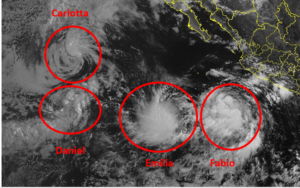Tropical Storm Dalila weakened as it moved away from Mexico on Sunday. At 11:00 a.m. EDT on Sunday the center of Tropical Storm Dalila was located at latitude 18.2°N and longitude 107.9°W which put the center about 235 miles (380 km) west-southwest of Manzanillo, Mexico. Dalila was moving toward the west-northwest at 9 m.p.h. (15 km/h). The maximum sustained wind speed was 50 m.p.h. (80 km/h) and there were wind gusts to 65 m.p.h. (105 km/h). The minimum surface pressure was 999 mb.
Tropical Storm Dalila weakened on Sunday when it moved over cooler water south of Baja California. Many of the thunderstorms in Dalila’s circulation weakened when the tropical storm move over cooler water. Thunderstorms were still occurring in bands in the western part of Tropical Storm Dalila. Bands in the other parts of Dalila’s circulation consisted primarily of showers and lower clouds. The thunderstorms remaining in Tropical Storm Dalila generated less upper level divergence. More mass was converging in the lower levels of the atmosphere which caused the surface pressure to increase.
The size of the circulation around Tropical Storm Dalila decreased as Dalila weakened. Winds to tropical storm force extended out 90 miles (145 km) from the center of Dalila’s circulation.
Tropical Storm Dalila will move through an environment unfavorable for intensification during the next 24 hours. Dalila will move over water where where the Sea Surface Temperatures are near 24°C. It will move under the southern part of an upper level ridge over southern Mexico and the adjacent part of the Eastern North Pacific Ocean. The upper level ridge will produce east-northeasterly winds that will blow toward the top of Dalila’s circulation. Those winds will cause the vertical wind shear to increase. Cooler Sea Surface Temperatures and more vertical wind shear will cause Tropical Storm Dalila to continue to weaken during the next 24 hours.
Tropical Storm Dalila will move around the southwestern part of a high pressure system over Mexico. The high pressure system will steer Dalila toward the west-northwest during the next 24 hours. On its anticipated track, Tropical Storm Dalila will continue to move farther away from the coast of southwestern Mexico.

